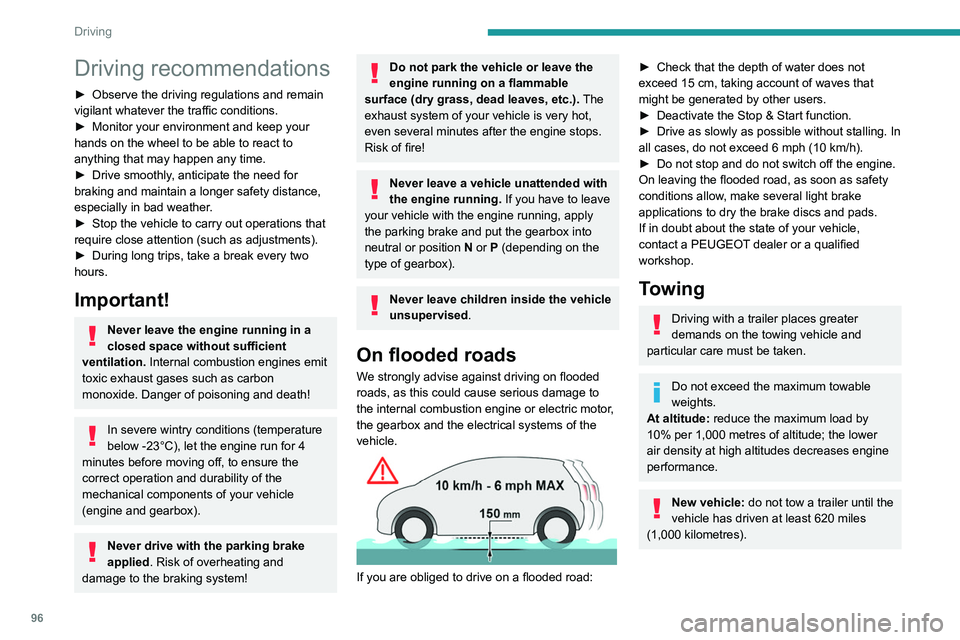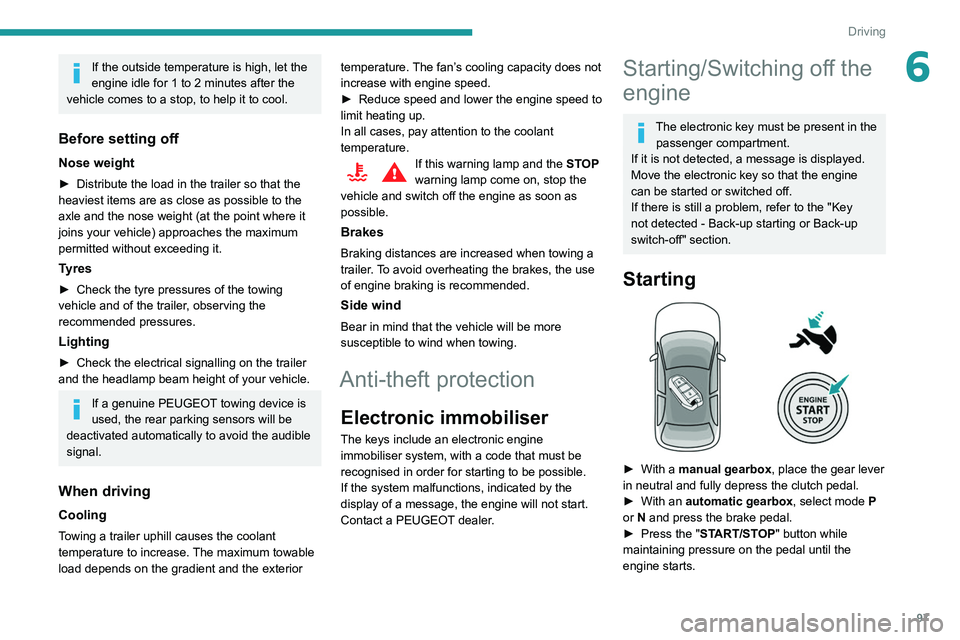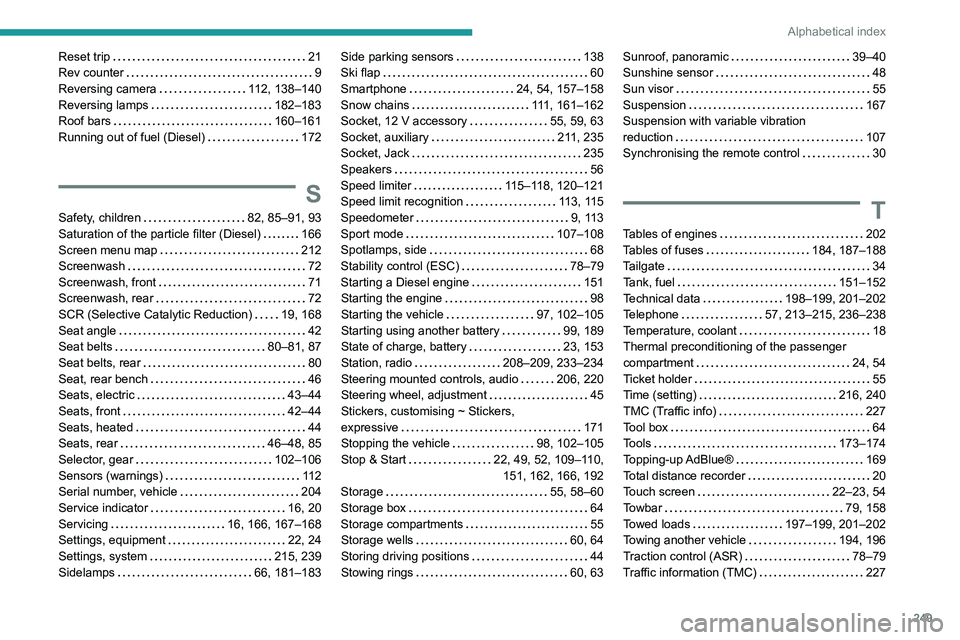Coolant sensor Peugeot 508 2020 Owner's Manual
[x] Cancel search | Manufacturer: PEUGEOT, Model Year: 2020, Model line: 508, Model: Peugeot 508 2020Pages: 276, PDF Size: 8.43 MB
Page 98 of 276

96
Driving
Driving recommendations
► Observe the driving regulations and remain
vigilant whatever the traffic conditions.
►
Monitor your environment and keep your
hands on the wheel to be able to react to
anything that may happen any time.
►
Drive smoothly
, anticipate the need for
braking and maintain a longer safety distance,
especially in bad weather.
►
Stop the vehicle to carry out operations that
require close attention (such as adjustments).
►
During long trips, take a break every two
hours.
Important!
Never leave the engine running in a
closed space without sufficient
ventilation. Internal combustion engines emit
toxic exhaust gases such as carbon
monoxide. Danger of poisoning and death!
In severe wintry conditions (temperature
below -23°C), let the engine run for 4
minutes before moving off, to ensure the
correct operation and durability of the
mechanical components of your vehicle
(engine and gearbox).
Never drive with the parking brake
applied . Risk of overheating and
damage to the braking system!
Do not park the vehicle or leave the
engine running on a flammable
surface (dry grass, dead leaves, etc.). The
exhaust system of your vehicle is very hot,
even several minutes after the engine stops.
Risk of fire!
Never leave a vehicle unattended with
the engine running. If you have to leave
your vehicle with the engine running, apply
the parking brake and put the gearbox into
neutral or position N or P (depending on the
type of gearbox).
Never leave children inside the vehicle
unsupervised.
On flooded roads
We strongly advise against driving on flooded
roads, as this could cause serious damage to
the internal combustion engine or electric motor,
the gearbox and the electrical systems of the
vehicle.
If you are obliged to drive on a flooded road:
► Check that the depth of water does not
exceed 15 cm, taking account of waves that
might be generated by other users.
►
Deactivate the Stop & Start function.
►
Drive as slowly as possible without stalling. In
all cases, do not exceed 6 mph (10
km/h).
►
Do not stop and do not switch off the engine.
On leaving the flooded road, as soon as safety
conditions allow
, make several light brake
applications to dry the brake discs and pads.
If in doubt about the state of your vehicle,
contact a PEUGEOT dealer or a qualified
workshop.
Towing
Driving with a trailer places greater
demands on the towing vehicle and
particular care must be taken.
Do not exceed the maximum towable
weights.
At altitude: reduce the maximum load by
10% per 1,000 metres of altitude; the lower
air density at high altitudes decreases engine
performance.
New vehicle: do not tow a trailer until the
vehicle has driven at least 620 miles
(1,000 kilometres).
If the outside temperature is high, let the
engine idle for 1 to 2 minutes after the
vehicle comes to a stop, to help it to cool.
Before setting off
Nose weight
► Distribute the load in the trailer so that the
heaviest items are as close as possible to the
axle and the nose weight (at the point where it
joins your vehicle) approaches the maximum
permitted without exceeding it.
Tyres
► Check the tyre pressures of the towing
vehicle and of the trailer, observing the
recommended pressures.
Lighting
► Check the electrical signalling on the trailer
and the headlamp beam height of your vehicle.
If a genuine PEUGEOT towing device is
used, the rear parking sensors will be
deactivated automatically to avoid the audible
signal.
When driving
Cooling
Towing a trailer uphill causes the coolant
temperature to increase. The maximum towable
load depends on the gradient and the exterior
Page 99 of 276

97
Driving
6If the outside temperature is high, let the
engine idle for 1 to 2 minutes after the
vehicle comes to a stop, to help it to cool.
Before setting off
Nose weight
► Distribute the load in the trailer so that the
heaviest items are as close as possible to the
axle and the nose weight (at the point where it
joins your vehicle) approaches the maximum
permitted without exceeding it.
Tyres
► Check the tyre pressures of the towing
vehicle and of the trailer , observing the
recommended pressures.
Lighting
► Check the electrical signalling on the trailer
and the headlamp beam height of your vehicle.
If a genuine PEUGEOT towing device is
used, the rear parking sensors will be
deactivated automatically to avoid the audible
signal.
When driving
Cooling
Towing a trailer uphill causes the coolant
temperature to increase. The maximum towable
load depends on the gradient and the exterior temperature. The fan’s cooling capacity does not
increase with engine speed.
►
Reduce speed and lower the engine speed to
limit heating up.
In all cases, pay attention to the coolant
temperature.
If this warning lamp and the STOP
warning lamp come on, stop the
vehicle and switch off the engine as soon as
possible.
Brakes
Braking distances are increased when towing a
trailer. To avoid overheating the brakes, the use
of engine braking is recommended.
Side wind
Bear in mind that the vehicle will be more
susceptible to wind when towing.
Anti-theft protection
Electronic immobiliser
The keys include an electronic engine
immobiliser system, with a code that must be
recognised in order for starting to be possible.
If the system malfunctions, indicated by the
display of a message, the engine will not start.
Contact a PEUGEOT dealer.
Starting/Switching off the
engine
The electronic key must be present in the passenger compartment.
If it is not detected, a message is displayed.
Move the electronic key so that the engine
can be started or switched off.
If there is still a problem, refer to the "Key
not detected - Back-up starting or Back-up
switch-off" section.
Starting
► With a manual gearbox, place the gear lever
in neutral and fully depress the clutch pedal.
►
With an
automatic gearbox, select mode P
or
N and press the brake pedal.
►
Press the "
START/STOP" button while
maintaining pressure on the pedal until the
engine starts.
Page 251 of 276

249
Alphabetical index
Reset trip 21
Rev counter
9
Reversing camera
112, 138–140
Reversing lamps
182–183
Roof bars
160–161
Running out of fuel (Diesel)
172
S
Safety, children 82, 85–91, 93
Saturation of the particle filter (Diesel)
166
Screen menu map
212
Screenwash
72
Screenwash, front
71
Screenwash, rear
72
SCR (Selective Catalytic Reduction)
19, 168
Seat angle
42
Seat belts
80–81, 87
Seat belts, rear
80
Seat, rear bench
46
Seats, electric
43–44
Seats, front
42–44
Seats, heated
44
Seats, rear
46–48, 85
Selector, gear
102–106
Sensors (warnings)
11 2
Serial number, vehicle
204
Service indicator
16, 20
Servicing
16, 166, 167–168
Settings, equipment
22, 24
Settings, system
215, 239
Sidelamps
66, 181–183
Side parking sensors 138
Ski flap
60
Smartphone
24, 54, 157–158
Snow chains
111, 161–162
Socket, 12 V accessory
55, 59, 63
Socket, auxiliary
211, 235
Socket, Jack
235
Speakers
56
Speed limiter
115–118, 120–121
Speed limit recognition
113, 115
Speedometer
9, 113
Sport mode
107–108
Spotlamps, side
68
Stability control (ESC)
78–79
Starting a Diesel engine
151
Starting the engine
98
Starting the vehicle
97, 102–105
Starting using another battery
99, 189
State of charge, battery
23, 153
Station, radio
208–209, 233–234
Steering mounted controls, audio
206, 220
Steering wheel, adjustment
45
Stickers, customising ~ Stickers,
expressive
171
Stopping the vehicle
98, 102–105
Stop & Start
22, 49, 52, 109–110,
151, 162, 166, 192
Storage
55, 58–60
Storage box
64
Storage compartments
55
Storage wells
60, 64
Storing driving positions
44
Stowing rings
60, 63Sunroof, panoramic 39–40
Sunshine sensor
48
Sun visor
55
Suspension
167
Suspension with variable vibration
reduction
107
Synchronising the remote control
30
T
Tables of engines 202
Tables of fuses
184, 187–188
Tailgate
34
Tank, fuel
151–152
Technical data
198–199, 201–202
Telephone
57, 213–215, 236–238
Temperature, coolant
18
Thermal preconditioning of the passenger
compartment
24, 54
Ticket holder
55
Time (setting)
216, 240
TMC (Traffic info)
227
Tool box
64
Tools
173–174
Topping-up AdBlue®
169
Total distance recorder
20
Touch screen
22–23, 54
Towbar
79, 158
Towed loads
197–199, 201–202
Towing another vehicle
194, 196
Traction control (ASR)
78–79
Traffic information (TMC)
227